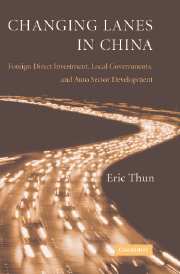Book contents
- Frontmatter
- Contents
- List of Figures and Tables
- List of Abbreviations
- Preface
- PART I INTRODUCTION
- PART II DEVELOPMENT IN A PROTECTED MARKET
- 3 Coordinating Development in the Auto Sector
- 4 Shanghai: A Local Developmental State
- 5 Beijing and Guangzhou: Laissez-Faire Local States
- 6 Changchun and Wuhan: Firm-Dominated Localities
- PART III DEEPENING GLOBAL INTEGRATION
- PART IV CONCLUSION
- Appendix on Research Methods
- Bibliography
- Index
5 - Beijing and Guangzhou: Laissez-Faire Local States
Published online by Cambridge University Press: 12 November 2009
- Frontmatter
- Contents
- List of Figures and Tables
- List of Abbreviations
- Preface
- PART I INTRODUCTION
- PART II DEVELOPMENT IN A PROTECTED MARKET
- 3 Coordinating Development in the Auto Sector
- 4 Shanghai: A Local Developmental State
- 5 Beijing and Guangzhou: Laissez-Faire Local States
- 6 Changchun and Wuhan: Firm-Dominated Localities
- PART III DEEPENING GLOBAL INTEGRATION
- PART IV CONCLUSION
- Appendix on Research Methods
- Bibliography
- Index
Summary
In many respects, the municipalities of Beijing and Guangzhou could not be more different. Beijing is a capital city, and with the exception of a few notable interludes, has been so since the thirteenth century. Although the occupants of Beijing's palaces and government offices periodically change, the city itself has remained the cultural and political epicenter of China. Guangzhou, located 1,887 kilometers to the south of the national capital, is distinctly on the periphery of the national scene. Rather than being a home to culture and politics it has thrived as a city of commerce and a window to the outside world. It has often enjoyed a great deal of independence from central power; at many points in Chinese history it has been utilized as a base for those who have challenged Beijing's rule. In Guangzhou, according to the often-quoted proverb, “the mountains are high and the emperor far away.” A city of traitors and traders was the description of one manager.
Despite these differences, the patterns of development in the auto sectors of these two cities have been remarkably similar. Both cities chose to promote the sector as a pillar industry, and in the mid-1980s both created joint venture auto assembly projects with the hope of fostering the development of a network of local supply firms. When the negotiations creating Beijing Jeep, a joint venture linking the Beijing Auto Works (BAW) and American Motor Company (AMC), were completed in April 1983, it was the only automobile joint venture in China (one year before SVW) and the largest manufacturing joint venture.
- Type
- Chapter
- Information
- Changing Lanes in ChinaForeign Direct Investment, Local Governments, and Auto Sector Development, pp. 136 - 171Publisher: Cambridge University PressPrint publication year: 2006



